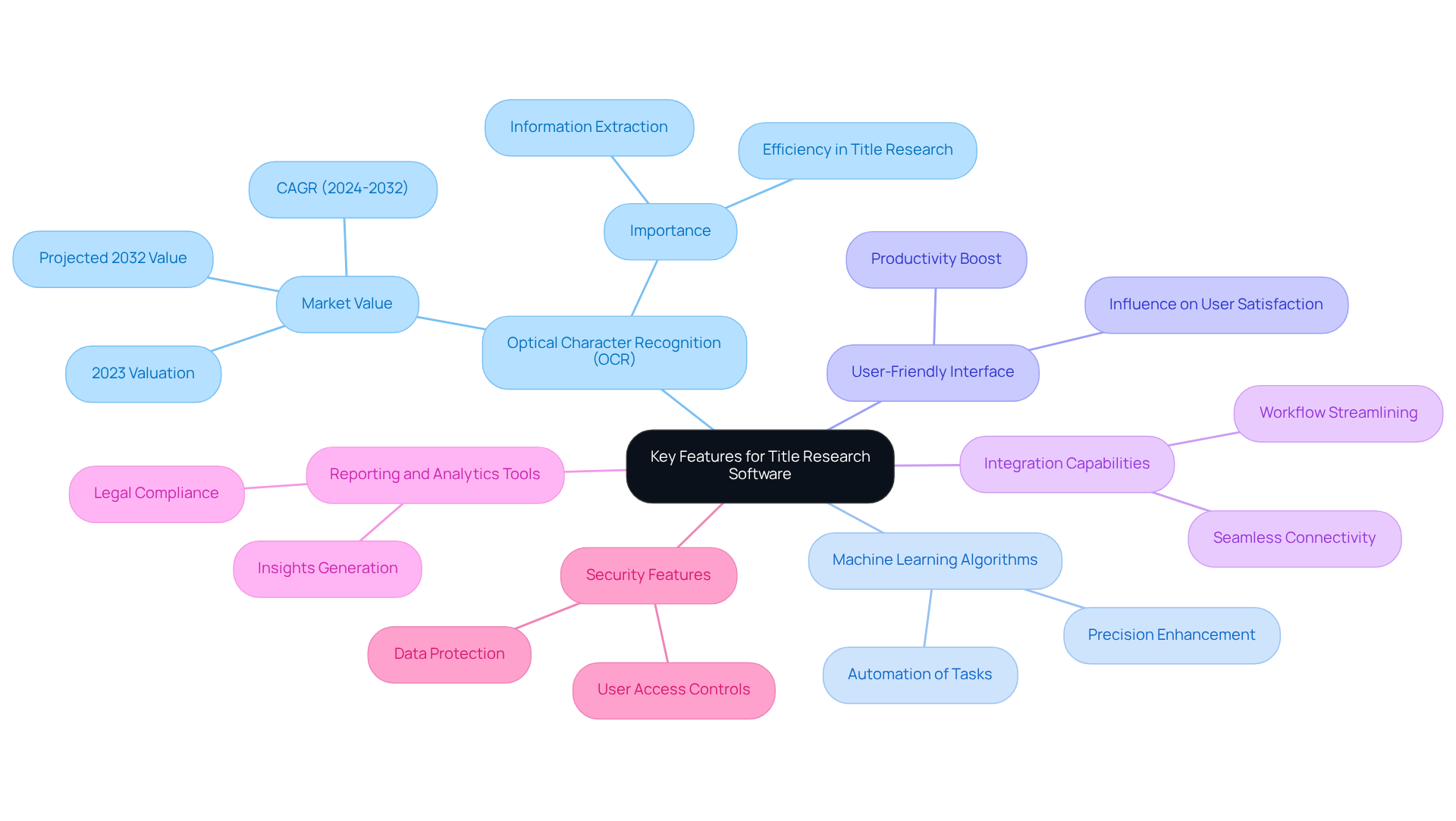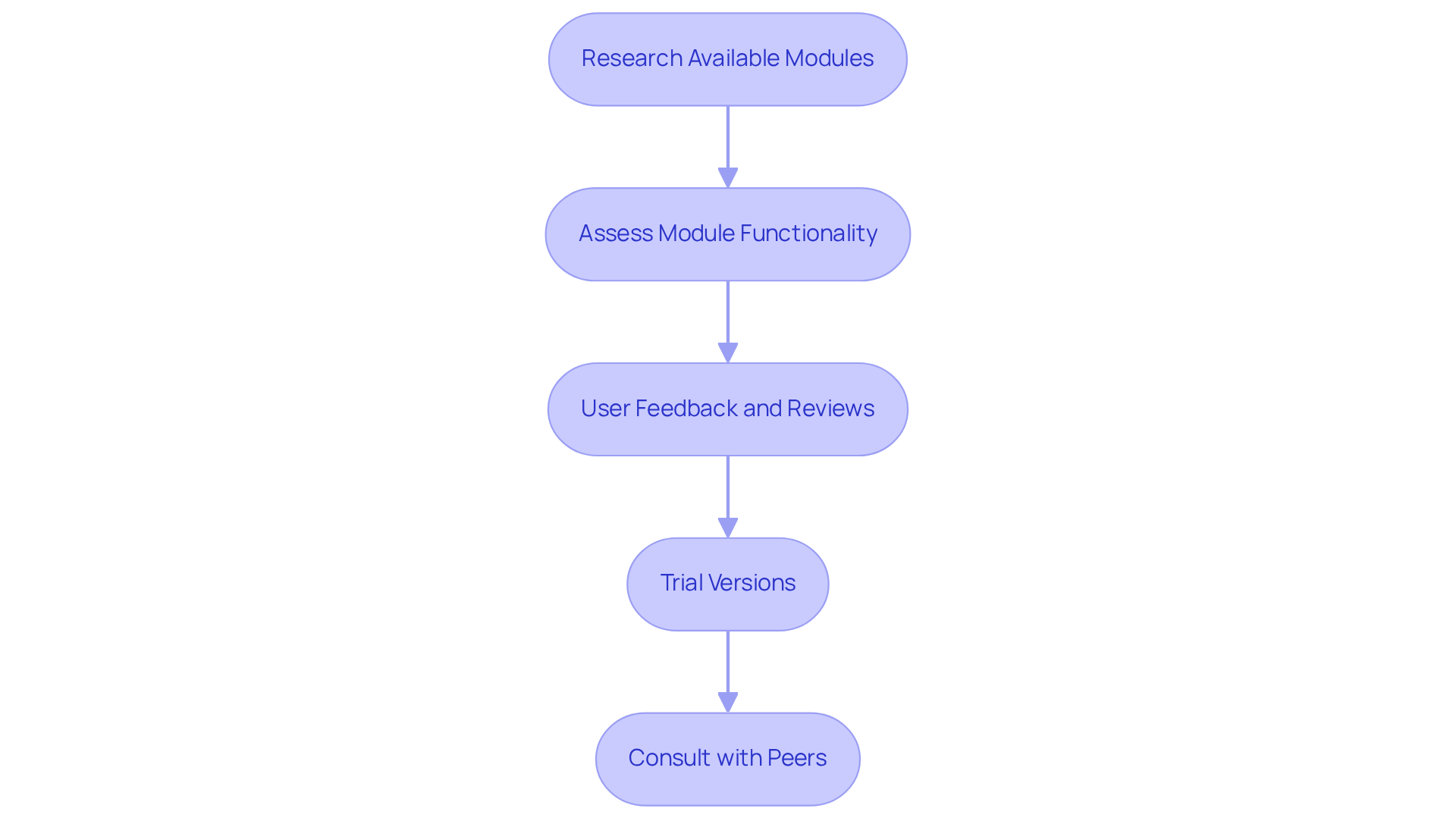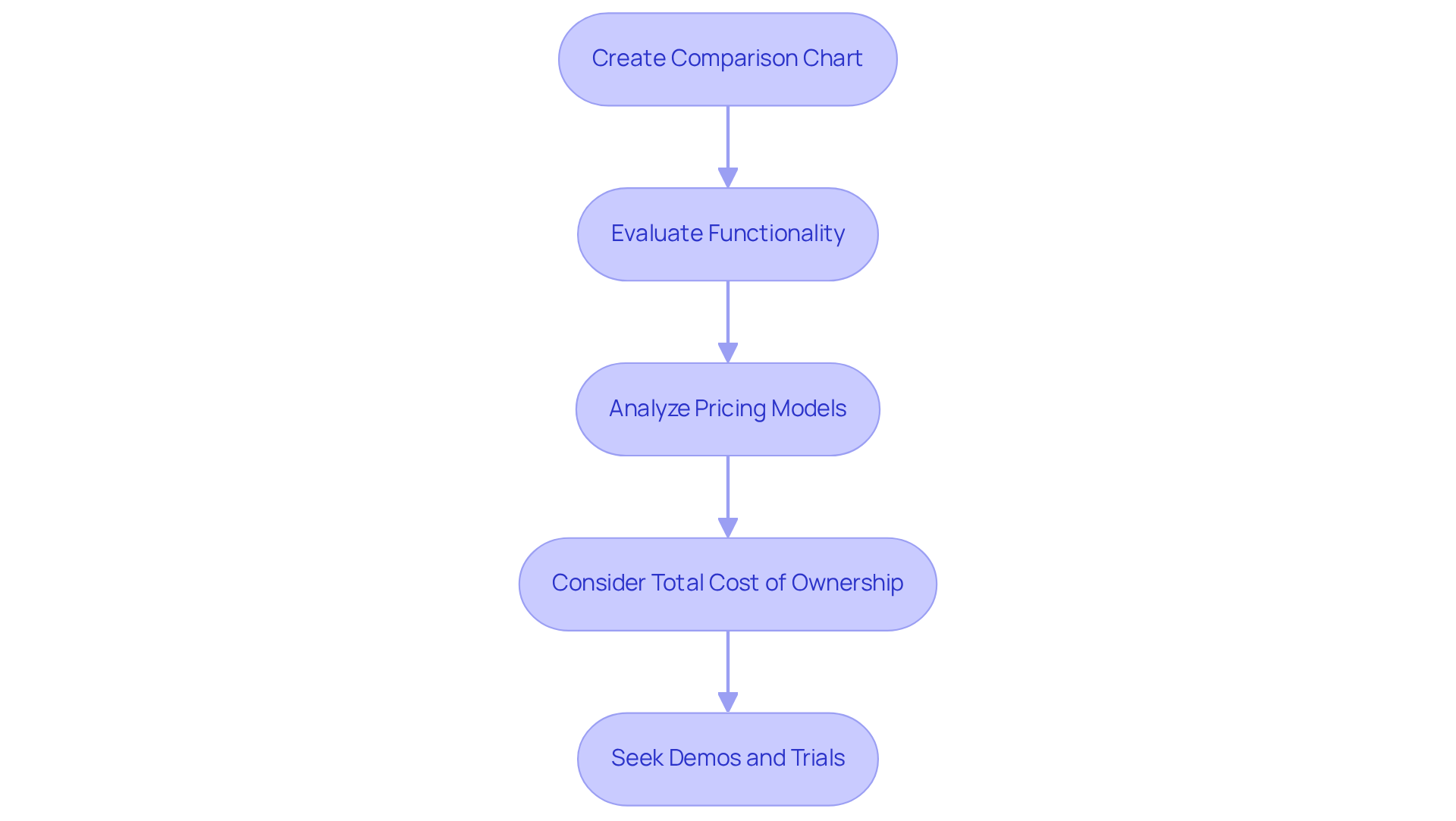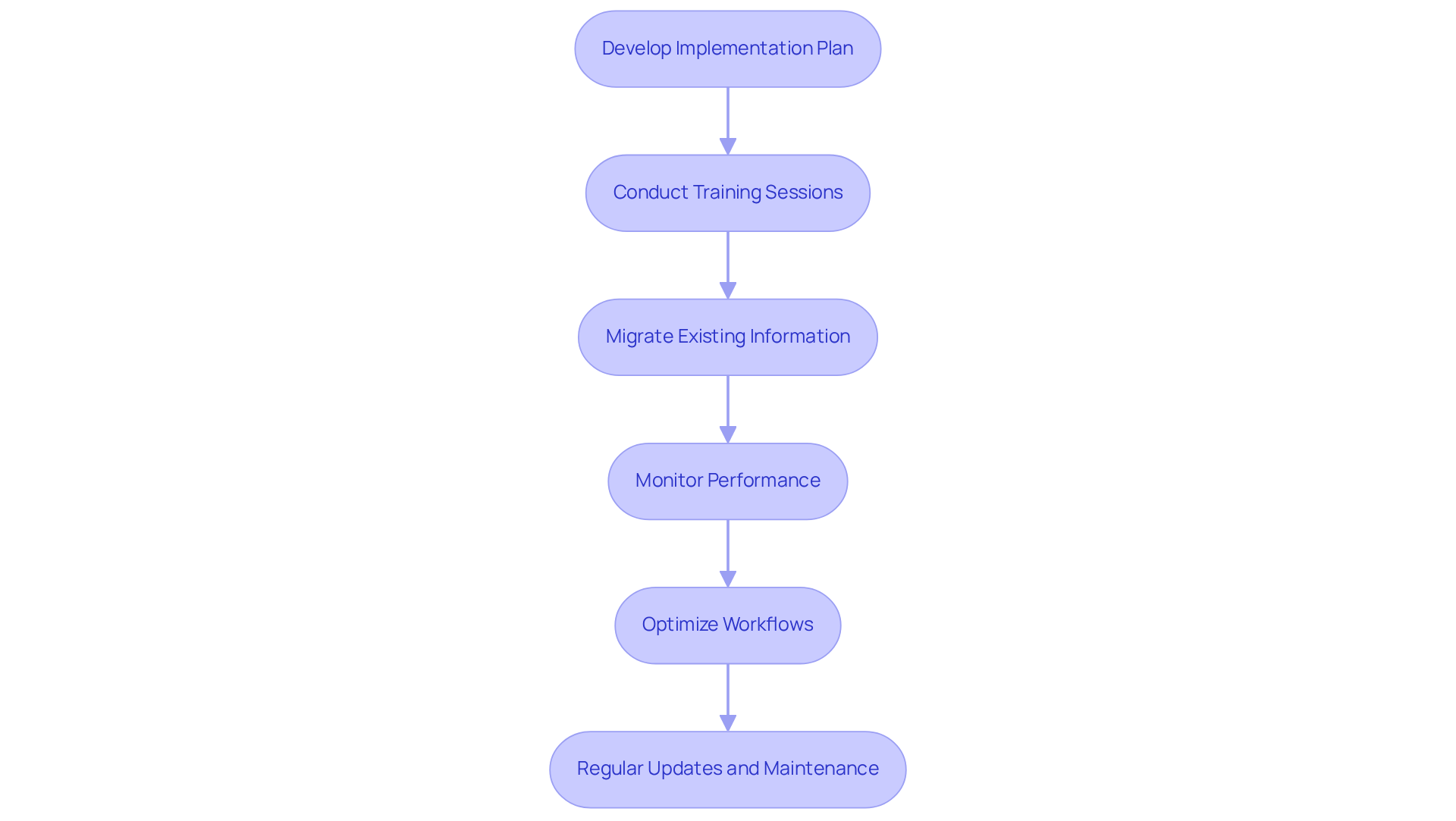Overview
The article emphasizes the critical features and evaluation criteria necessary for mastering real estate software, particularly those equipped with land records modules. It underscores the significance of functionalities such as:
- Optical Character Recognition
- Machine learning algorithms
- User-friendly interfaces
- Integration capabilities
These elements are vital for enhancing efficiency in title research, as supported by industry data and expert recommendations. Furthermore, understanding these functionalities is essential for navigating the challenges faced in accurate title research, ultimately leading to improved outcomes in the field.
Introduction
Navigating the complexities of real estate transactions demands not only expertise but also the right technological tools. The growing demand for efficient title research underscores the necessity for professionals to master real estate software, particularly those equipped with robust land records modules. This article explores the key features essential for effective title research software, evaluates land records modules, and outlines best practices for implementation and optimization. However, with a plethora of options available, how can one ascertain which software truly enhances efficiency and productivity in an ever-evolving market?
Identify Key Features for Title Research Software
To effectively identify key features for title research software, consider the following:
- Optical Character Recognition (OCR): This essential feature enables the application to convert various document types, including scanned paper documents and PDFs, into editable and searchable formats. The OCR market was valued at USD 11.84 billion in 2023 and is projected to grow significantly, reaching USD 43.26 billion by 2032. This underscores its importance in quickly extracting information from title documents. This growth reflects a compound annual growth rate (CAGR) of 15.52% from 2024 to 2032, indicating a robust demand for OCR solutions in the real estate sector.
- Machine Learning Algorithms: Look for applications that utilize machine learning to enhance information precision and automate repetitive tasks. This technology can drastically reduce the time spent on manual data entry and verification. The OCR market is expected to grow at a CAGR of 15.52% from 2024 to 2032, driven by advancements in AI and machine learning.
- : A clean, intuitive interface is essential for ensuring users can navigate the application effortlessly, minimizing the learning curve and boosting productivity. According to industry specialists, a user-friendly layout greatly influences user satisfaction and efficiency, making it a crucial factor when choosing applications.
- Integration Capabilities: The application should seamlessly connect with other tools and databases used in real estate transactions, such as CRM systems and real estate software with land records modules, facilitating a more streamlined workflow.
- Reporting and Analytics Tools: Strong reporting capabilities allow users to produce insights and summaries rapidly, assisting in decision-making and adherence to legal obligations. The demand for such capabilities is rising as organizations prioritize digital transformation.
- Security Features: Given the sensitive nature of property information, it is vital to ensure the application incorporates strong security measures, including encryption and user access controls, to protect against unauthorized access.
By concentrating on these features, real estate experts can choose tools that significantly improve their title research processes. As noted by industry leaders, "The integration of OCR technology is transforming the efficiency of title research, allowing for faster and more accurate data handling.

Evaluate Land Records Modules in Software Solutions
When evaluating land records modules in software solutions, it is essential to follow a systematic approach:
-
Research Available Modules: Begin by compiling a comprehensive list of real estate software with land records modules, specifically targeting those applications designed for title research and real estate professionals.
-
Assess Module Functionality: Examine the functionalities of each module, focusing on key aspects such as:
- Search Capabilities: Evaluate whether the module can perform complex searches across multiple databases.
- Data Entry Automation: Determine if it automates data entry processes to minimize manual work.
- Document Management: Assess how effectively it manages and organizes documents related to land records.
-
User Feedback and Reviews: Investigate to gauge the effectiveness of the modules. Pay close attention to comments regarding ease of use, reliability, and customer support. Notably, a high client retention rate of 98% can indicate strong satisfaction with the solutions.
-
Trial Versions: If accessible, utilize trial versions of the application to test the modules firsthand. This hands-on experience will provide valuable insights into their usability and effectiveness in real-world scenarios.
-
Consult with Peers: Engage with fellow real estate professionals to gather their experiences and recommendations regarding specific program modules. As Will Rogers wisely observed, timing is essential in real estate; likewise, prompt consultations can lead to improved selections.
By thoroughly evaluating land records systems, you can select real estate software with land records modules that significantly enhances your title research efficiency. For instance, digital solutions that process nearly 14 million documents each year exemplify the potential for improved productivity and efficiency.

Compare Software Options Based on Functionality and Cost
To effectively compare software options based on functionality and cost, follow these steps:
-
Create a Comparison Chart: Compile a list of the application options under consideration, detailing their main characteristics, functionalities, and pricing structures. This visual representation allows for quick identification of differences and similarities.
-
Evaluate Functionality: Assess how effectively each application option fulfills your identified key features. Consider the following aspects:
- Customization Options: Determine if the software can be tailored to fit your specific workflow requirements. The increasing demand for customizable technological solutions is evident in the market, as companies seek tools that adapt to their unique needs.
- Scalability: Assess if the application can support your future growth requirements, ensuring it remains pertinent as your operations increase.
- Customer Support: Investigate the level of support provided by the vendor and their responsiveness to inquiries and issues.
-
Analyze Pricing Models: Examine the pricing structures of each application option. Consider whether they charge a one-time fee, subscription-based pricing, or usage-based fees. Assess what is included in the price, such as updates, support, and additional features. As Warren Buffett noted, "Price is what you pay. Value is what you get," emphasizing the importance of understanding pricing in relation to the value offered.
-
Consider Total Cost of Ownership: Beyond the initial purchase price, factor in ongoing costs such as maintenance, training, and potential upgrades. This comprehensive view will provide a clearer picture of the associated with each option.
-
Seek Demos and Trials: Request demonstrations or trial periods for the program options you are considering. Interacting with the application firsthand will assist you in assessing usability and functionality in your specific context.
By thoroughly comparing application options, you can make an informed decision that aligns with both your functional needs and budget, ultimately enhancing your title research efficiency. The global real estate technology market is projected to expand at a CAGR of 12.8% from 2023 to 2030, highlighting the urgency of making informed technology choices in a rapidly evolving landscape.

Implement and Optimize Your Selected Software Solution
To implement and optimize your selected software solution effectively, consider the following steps:
- Develop an Implementation Plan: Create a detailed plan that outlines timelines, responsibilities, and key milestones for the system rollout. Ensure all stakeholders understand their roles to foster accountability.
- Conduct Training Sessions: Organize comprehensive training sessions tailored to your team’s needs. Focus on essential functionalities and best practices, as effective training can lead to a 50% increase in software usage rates within the first quarter. Engaging training solutions are crucial for enhancing user confidence and proficiency with new tools. In fact, 70% of agents reported that personalized training significantly improved their proficiency with new tech tools.
- Migrate Existing Information: Plan the transfer of existing information meticulously. Clean and format data correctly to prevent issues during the transfer, as inadequate mapping can result in up to 40% data loss.
- Monitor Performance: After implementation, closely observe the system's performance. Collect user feedback to identify challenges and areas for improvement, as 83% of senior executives cite user adoption as a primary challenge in CRM systems.
- Optimize Workflows: Continuously assess how the application integrates into your existing workflows. Look for opportunities to streamline processes, such as automating repetitive tasks or integrating with other tools, which can enhance overall productivity by up to 30%. This is particularly important as 65% of compliance failures stem from employee errors, highlighting the need for effective training.
- Regular Updates and Maintenance: Stay informed about and new features. Consistently assess performance metrics and make required modifications to ensure the system continues to meet your evolving needs.
By following these steps, you can successfully implement and optimize your software solution, significantly enhancing efficiency in title research and improving overall operational effectiveness. Additionally, consider referencing case studies, such as the 'Digital Software Adoption Training,' which illustrates the successful implementation of training in a different industry, to further support your approach.

Conclusion
Mastering real estate software, particularly those equipped with land records modules, is crucial for enhancing title research efficiency and streamlining workflows. The integration of advanced technologies such as Optical Character Recognition (OCR) and machine learning significantly boosts the speed and accuracy of data handling. Thus, it is essential for real estate professionals to select software that meets their specific needs.
Key features, including:
- User-friendly interfaces
- Robust security measures
- Strong reporting tools
are vital for effective title research. By evaluating various software options based on functionality and cost, professionals can ensure they are making informed decisions that align with both their operational requirements and budget constraints. Furthermore, a systematic approach to assessing land records modules enhances the ability to select the best tools available in the market.
As the real estate technology landscape continues to evolve, embracing these advanced software solutions will not only improve operational efficiency but also position professionals to adapt to future market demands. Investing time in the careful selection, implementation, and optimization of real estate software is not merely a choice; it is a strategic necessity for success in an increasingly competitive field.
Frequently Asked Questions
What is Optical Character Recognition (OCR) and why is it important for title research software?
OCR is a feature that enables the software to convert various document types, such as scanned paper documents and PDFs, into editable and searchable formats. It is important for title research software because it allows for quick extraction of information from title documents, enhancing efficiency.
How is the OCR market projected to grow in the coming years?
The OCR market was valued at USD 11.84 billion in 2023 and is projected to grow to USD 43.26 billion by 2032, reflecting a compound annual growth rate (CAGR) of 15.52% from 2024 to 2032.
What role do machine learning algorithms play in title research software?
Machine learning algorithms enhance information precision and automate repetitive tasks, significantly reducing the time spent on manual data entry and verification, thereby improving overall efficiency.
Why is a user-friendly interface important in title research software?
A user-friendly interface is essential for ensuring that users can navigate the application easily, which minimizes the learning curve and boosts productivity. It greatly influences user satisfaction and efficiency.
What are integration capabilities in title research software?
Integration capabilities refer to the software's ability to seamlessly connect with other tools and databases used in real estate transactions, such as CRM systems and real estate software with land records modules, facilitating a more streamlined workflow.
What are reporting and analytics tools, and why are they important?
Reporting and analytics tools allow users to produce insights and summaries quickly, which assists in decision-making and adherence to legal obligations. Their demand is rising as organizations prioritize digital transformation.
What security features should title research software include?
Title research software should incorporate strong security measures, such as encryption and user access controls, to protect sensitive property information against unauthorized access.
How do these key features improve title research processes?
By focusing on features like OCR, machine learning, user-friendly interfaces, integration capabilities, reporting tools, and security, real estate experts can choose tools that significantly enhance the efficiency and accuracy of their title research processes.




